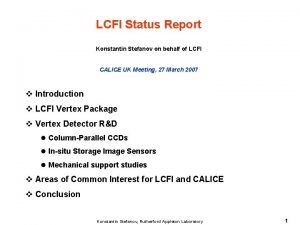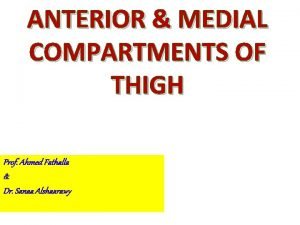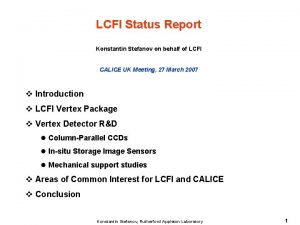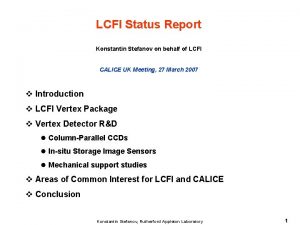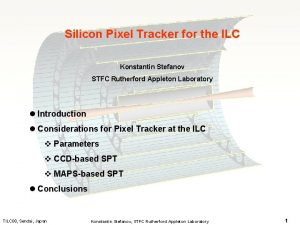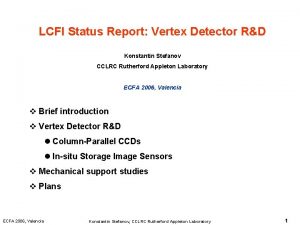Lecture 9 Dimitar Stefanov Recapping DC and AC



























- Slides: 27

Lecture 9 Dimitar Stefanov

Recapping DC and AC instrumentation amplifiers: • Errors due to the capacitance of the shielded wires that connect electrodes with the amplifier • The capacitors between the electrodes and the input stage of the amplifier cause charging effects from the input bias current. • Solution of the problem: Input guarding


Differential Shield Driver Common-Mode Shield Driver 5 mm X 4 mm X 1. 75 mm !

Techniques which eliminate` the influence of the capacitance of the connective electrode wires

Best elimination of the capacitance – if no wires are used. Bipolar Concentric ring sensor for surface Laplacian ECG (University of Miami) Double-sided 13 x 13 mm PC board The contact area of the outer ring and the inner dot are equal. More information: M. Talero, C. C. Lu, Active Bipolar Concentric Ring Sensor for surface Laplacian ECG, in the Proc. First BMES/EMBS conference on Serving Humanity, Advancing Technology, Oct. 13 -16, 1999, Atlanta, GA, USA

Tripolar electrode sensor for Laplacian cardiograms (University of Miami, Department of Biomedical Engineering) The sensor contains three closely spaced rings. The width of each ring is 1. 0 mm. The diameters of the outer ring and the middle ring are 36 mm and 18 mm respectively. The ring/dot in the center is 2. 0 mm in diameter. An instrumentation amplifier with an input impedance of 10 Gohms is used. Further information: http: //sbec. abe. msstate. edu/abstracts/lu. htm

Wireless electrodes for surface electromyography (Keio University – Japan) üElectrode part (Ag/Ag. Cl electrodes) + amplifier + high-pass filter + built-in transmitter + battery üInstrumentation amplifier AD 620 BR üFM transmitter üfive button battery cells ü 20 m distance between the electrodes and the receiver ü 15 hours operation with one set batteries.


Before transmission After transmission More information: M. Ohyama, Y. Tomita, S. Honda, H. Uchida, and N. Matsuo, Active wireless electrodes for surface electromyography, Proc. Of the 18 th Annual International Conference of the IEEE EMBS, Amsterdam, 1996, pp. 295 – 296.

Micro system for sensing of biological parameters (Waseda University – Japan) • There are no wire lines between the sensors and the transmitter. One transmitter, located on the wrist, is used for transmission of the data from all sensors. • Between the detector part and the transmitter, the signals are sent as a AC micro current flow through the tissue of the body.

ECG monitoring system The dipole map for the heart from Waller (1889) (All electrodes are mounted on a common frame. The distance between the electrodes is 5 cm. )

A. / Block diagram of the ECG detector transmitter Sampling frequency – 900 Hz Carrier frequency – 70 k. Hz (sinusoidal signal)

B. / Block diagram of the relay transmitter C. / Transmission of the signals between the ECG transmitter and the relay transmitter (transmission of the signal in the human body): Tissue equivalent circuit

Equivalent circuit of the tissue-electrodes contour

D. / Frequency characteristic The distance between the electrodes RF and T (electrodes where the signals are applied) is 7 cm. The distance between the electrodes B, S and T (electrodes for detection of the signals) is 3 cm. In case of two channels, two carrier frequencies are chosen: 50 k. Hz and 70 k. Hz. More information: T. Handa, S. Shoji, S. Ike, S. Takeda, and T. Sekiguchi, A Very low-power consumption wireless ECG monitoring system using body as a signal transmission medium, Proc. Transducer’ 97 - Int. Conf. On solid-state sensors and actuators, Chicago, June 16 -19, 1997 Eiji Takeda, Takashi Handa, Shuichi Shoji, Akihiko Uchiyama, STUDIES ON BIO-SENSING MICROSYSTEMS FOR HEALTH CARE, XIV International Symposium on Biotelemetry, Marburg, Germany April 6 - 11, 1997, http: //baby. indstate. edu/isb/publications/abstracts/session 3 -6. htm

Prosthetics and Orthotics Amputations Result of: • Decrease in blood supply to the muscles and periphery (diseases of the arteries to the limbs or diabetes). • Automobile and motorcycle accidents • Bone cancers and tumors • Direct trauma (train wheels, power saw) • Osteomyelitus and other infections • War and natural disasters. Prosthesis – device which replaces a part of the functions of a missing limb.

Prosthetics and Orthotics Orthosis – device which is applied to the exterior of the body to stabilize or enhance motion of a limb or joint. Functions of the orthoses : • to reduce the stress on body parts; • to protect of diseased or injured limbs • to prevent or correct skeletal deformities; • to stabilize joints.

- Post-operative treatment for amputations Temporary prostheses – applied after the surgical operation and minimize loss of sensory motor coordination. Prosthesis - example socket (individually fitted component) residual limb (soft tissue and bones)

Orthosis - example Classification of the prostheses: 1. 2. 3. 4. Upper-limb and lower-limb prostheses Functional and cosmetic prostheses Body-driven and external-power-driven prostheses (body-operated, cablecontrolled, electrically operated) External power: electrical power (batteries), pneumatic and hydraulic driven (some old models)

Classification based on the level of amputation : 1. Upper-limb prostheses can be classified as shoulder disarticulation prostheses, above-elbow (AE) prostheses, below-elbow (BE) prostheses 2. Lower-limb prostheses can be classified as above-the-knee (AK) prostheses and below-theknee (BK) prostheses

Functional classification of orthoses: 1. 2. 3. 4. Immobilization or stabilization of joints and limbs (A) Prevention of skeletal and joint deformations (B) Chance of the position of a body part (traction) in case of weak muscle performance (C). tremor-suppression orthosis (D). B A C

Tremor-suppression orthosis Jack Kotovsky and Michael J. Rosen, A wearable tremor-suppression orthosis, in the Journal of Rehabilitation Research and Development, Vol. 35 No. 4, October 1998, pp. 373 -387 The orthosis damps wrist flexion and extension tremor. constrained layer damping (CLD) Fluid damping Pneumatic damping • Active damping orthoses - permits electrically tunable damping. • Piezoelectric or electro-rheological (ER) damping elements - their damping properties may be controlled with an applied voltage.

Prosthesis = functionality + good cosmetic appearance Energy sources: • External power – electric, pneumatic and mechanical • Body power. Actuators: electromotor, piston, “Mc. Kibben” artificial muscle Prosthesis fitting Design of customized components to match to body shape. Socket: • most critical element of the prosthesis: • individually fitted component of the prosthesis • in contract with the residual limb. Fitting: • casting the residual limb – a cast of the residual limb is used to make a socket for the prosthesis. • CAD-CAM methods

Illustration of CAD-CAM above-knee (AK) socket design Ultrasonic and computer tomography – future aspects of the CAD-CAM socket design • Instead of casting, a non-invasive imaging process is applied. • The external shape and the external tissue structure of the residual limb are recorded.

• Prosthesis often can be made lighter than the limb it replaces. • Prosthesis length – near the length of the natural limb. Upper-extremity prostheses Terminal devices allow grasping functions Internally or externally powered Mechanical hook Voluntary opening and closing Cosmetic glove to a hook

 Dimitar sasselov
Dimitar sasselov John nochev
John nochev Dimitar obshti
Dimitar obshti Konstantin stefanov
Konstantin stefanov Saug etf
Saug etf 01:640:244 lecture notes - lecture 15: plat, idah, farad
01:640:244 lecture notes - lecture 15: plat, idah, farad Electricity and magnetism lecture notes
Electricity and magnetism lecture notes Power system dynamics and stability lecture notes
Power system dynamics and stability lecture notes Microbial physiology and metabolism lecture notes
Microbial physiology and metabolism lecture notes Ternology
Ternology Parallel and distributed computing lecture notes
Parallel and distributed computing lecture notes Hole basis fits
Hole basis fits Financial markets and institutions ppt
Financial markets and institutions ppt Banking and finance lecture
Banking and finance lecture Extempore and lecture
Extempore and lecture Utilities and energy lecture
Utilities and energy lecture Catherine belsey books
Catherine belsey books Design of mechatronics system ppt
Design of mechatronics system ppt Vct monitoring foetal
Vct monitoring foetal Lecture on love courtship and marriage
Lecture on love courtship and marriage Power system dynamics and stability lecture notes
Power system dynamics and stability lecture notes Project planning and management lecture notes ppt
Project planning and management lecture notes ppt Intermascular septa
Intermascular septa Project procurement management lecture notes
Project procurement management lecture notes Lecture about sport
Lecture about sport Lecture on healthy lifestyle
Lecture on healthy lifestyle Nihilism vs existentialism
Nihilism vs existentialism Life lecture meaning
Life lecture meaning



